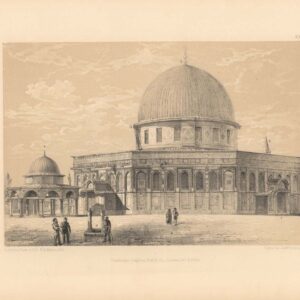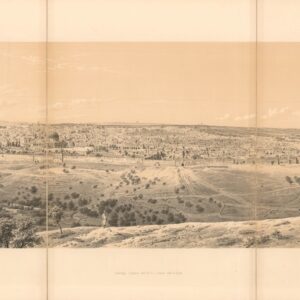19th-century architectural plan of the Armenian Church of Saint James.
Plans and sections of the Armenian Church of S. James, and mosaics.
Out of stock
Description
This plate is one of several compiled by Pierotti that contains more than a single main subject or image. Here we have a detailed architectural plan of the Armenian Church of Saint James (a.k.a. the Cathedral of Saint James or the Armenian Cathedral of Saint Jacob), complemented by a cross-section of the building and several insets showing some of the ornamental detail (in this case, mosaic designs). The cathedral is located near the Zion Gate in the Armenian Quarter of Old Jerusalem. The Armenian church is among the oldest functioning churches in the Old City and is dedicated to two of Jesus’ Twelve Apostles: James, the son of Zebedee (James the Greater), and James, the brother of Jesus (James the Just).
The cathedral’s history can be traced back to the 12th century, when medieval pilgrim, Johan of Würzburg, visited Jerusalem in 1162. From his descriptions, we can surmise that the Cathedral of Saint James had been completed and taken into use by then. This has led some historians (e.g. Nurith Kenaan-Kedar) to speculate that it was built during the reign of Queen Melisende, the eldest daughter of the Crusader King, Baldwin II of Jerusalem. Melisende reigned as regent for her son between 1131 and 1153 and may have commissioned the church during this period. Part of the motivation may have been her Armenian heritage on her mother’s side. Whether true or not, Saint James is generally considered one of the oldest active cathedrals in the city.
The church is the principal place of worship for the Armenian Patriarchate of Jerusalem (also known as the Armenian Patriarchate of Saint James). It is a popular site for pilgrims who come to visit and pay their respects to the holy apostles and the Armenian Patriarchate. Its stunning architecture and intricate design make it an important architectural landmark and a destination for anyone interested in the city’s religious history and culture. As is common in Pierotti’s lithographed plans and views, this plate has been supplied with subtle labelling, referencing a numbered legend on an accompanying sheet:
1. Portico.
2. Church of S. James.
3. Altars.
4. Throne for the Armenian Patriarch of Jerusalem.
5. Door of the Chapel of S. Stephen.
6. Altar of the Latins for the Commemoration of the Feast of S. James.
7. Site of the Martyrdom of S. James.
8. Door of the Treasury.
9. Tomb of the Armenian Patriarch Magar.
10. Altar.
11. Passage of the Gallery.
12. Throne for the Armenian Patriarch Magar.
13. Iron Barrier.
14. Treasury.
15. Chapel of S. Stephen.
16. Passages to the Armenian Convent.
17. Chapel of S. Miazim.
18. Ancient Stones.
19. Staircase of the Gallery.
20. Entrance to the Chapel of S. Miazim.
C. Ancient Mosaics.
D. Modern Mosaics.
(S. C.) Conventional Signs.
a. Ancient Wall.
b. Less ancient Wall.
c. Modern Wall.
d. Less modern Wall.
e. The Black colour in the Mosaics.
f. The Red colour.
g. The Yellow colour.
Publication information
In 1864, the same year that the first British Ordnance Survey of Jerusalem was commissioned, Italian engineer Ermete Pierotti published Jerusalem Explored, a seminal work on the history, archaeology, and architectural history of the ancient and holy city. This work included Pierotti’s notes and insights after years of surveying and mapping under Ottoman authority. The publication was divided into a text volume and a volume of plates. The latter included 63 lithographs showing everything from strategic views, across architectural plans and section profiles, to panoramic vistas of the Old City. Most of the lithographed plates were based either on photographs or drawings made by Pierotti and his team.
The plates were lithographed mainly by Thomas Picken of London and printed by the prominent British lithography firm William Day & Sons.
Cartographer(s):
Ermete Pierotti (1820-1880) was the oldest of nine siblings in a family from Pontardeto in Pieve Fosciana (the family built the Palazzo Pierotti, which has served as the town hall since 1877). Pierotti worked as a military engineer in Genoa and later served as a captain in the Engineering Corps of the Sardinian King. In 1849, he was accused of desertion and the theft of 3596 lire from the troop’s treasury, which resulted in a dishonorable discharge from the army. Pierotti then traveled to Jerusalem and Egypt, where he worked as an engineer. In Egypt, he discovered the foundations of the Alexandria Library while laying the foundations for a Greek church, but it was in Jerusalem that he would put his surveying and engineering skills to work.
Pierotti arrived in Jerusalem in 1854 as a consultant for the Franciscan Order, which had custody of many of the Christian holy sites in the city. During his time there, Pierotti was involved in the restoration of the Crusader Era Church of St. Anne, located in the Old City near the Pool of Bethesda. Working with Ottoman engineer Assad Effendi, he later contributed to the restoration of the Qanat as-Sabil, the main aqueduct that supplied Jerusalem with water, which involved repairing the aqueduct’s channels and cisterns. Other building projects included work on the Temple Mount itself and the construction of both the Austrian Hospice and the so-called Alexanderhof (HQ of the Kaiserlichen Orthodoxen Palästina-Gesellschaft) in the Christian Quarter of the Old City. And finally, he helped design the road from Jaffa to Jerusalem, a significant engineering feat at the time.
Pierotti became interested in the city’s history and archeology during his time in Jerusalem. He conducted several excavations in the Old City. He discovered several important artifacts, including an inscription in the Church of the Holy Sepulchre that proved the existence of a church on the site during the Byzantine period. Pierotti’s work in Jerusalem earned him a reputation as a skilled engineer and pioneering archeologist. He became known for his attention to detail and ability to work under challenging conditions. In addition to his many projects, Pierotti’s legacy consists of publishing his magnum opus: Jerusalem Explored. A Description of the Ancient and Modern City (1864), which included an entire volume of lithographed plates based on Pierotti’s plans and converted photographs.
Despite his many successes, Pierotti’s work and position annoyed the British, who increasingly sought to establish a scientific presence in the Holy City, if not a colonial one. When competition arose between Pierotti and Captain Charles Wilson’s team of English Royal Engineers conducting the first Ordnance Survey of Jerusalem and surroundings in 1864, Pierotti’s reputation was deliberately tarnished by the disclosure of his criminal past, and for the rest of his life, he struggled to regain recognition for his achievements.
Condition Description
Very good.
References
![[Old Damascus]](https://neatlinemaps.com/wp-content/uploads/2019/09/NL-00657-scaled-300x300.jpg)
![[Old Damascus]](https://neatlinemaps.com/wp-content/uploads/2019/09/NL-00657-scaled.jpg)
![[ALEPPO] Toi qui te plains de l’infortune, Lève-toi et va vers… ALEP… Comme le malade épuisé. Soupire après la guérison.](https://neatlinemaps.com/wp-content/uploads/2024/05/NL-01445-cover_thumbnail-300x300.jpg)

